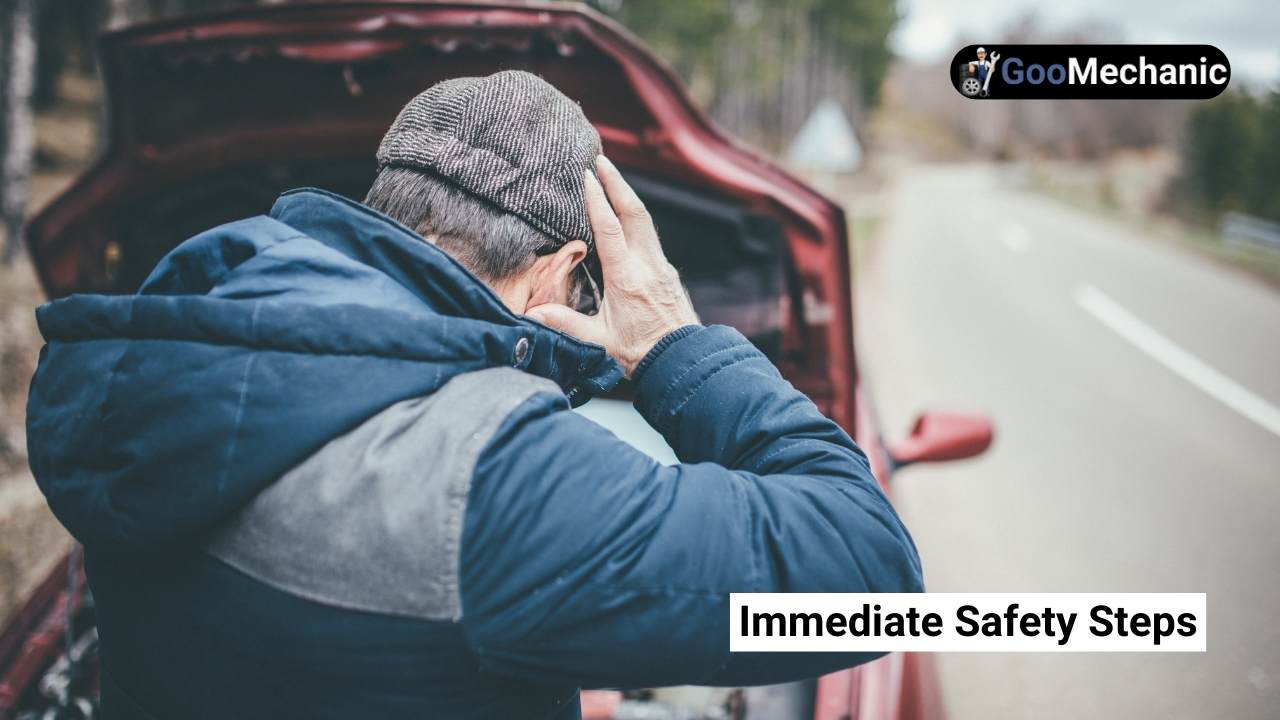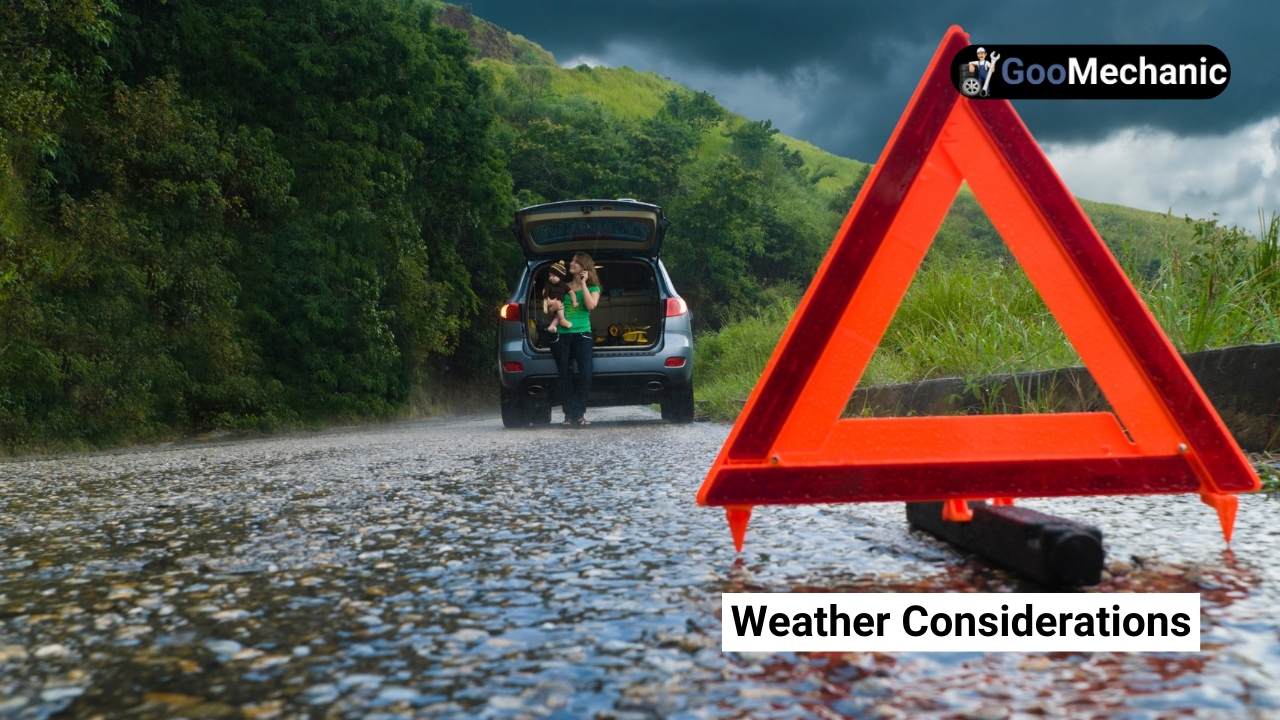Place flares or reflective signs behind your vehicle immediately after it breaks down. Ensure they are visible to oncoming traffic.
Vehicle breakdowns can be stressful and dangerous, especially on busy roads. Safety is a top priority in such situations. Placing flares or reflective signs helps alert other drivers to your presence, reducing the risk of accidents. These signs should be positioned at a safe distance to give ample warning.
Always carry these emergency items in your vehicle. Proper use of flares or reflective signs not only protects you but also aids in smoother traffic flow around your disabled vehicle. Being prepared with these tools can make a significant difference in emergency situations.
Immediate Safety Steps

Car breakdowns can happen to anyone. Knowing the immediate safety steps is crucial. These steps ensure your safety and others on the road. Follow these guidelines carefully to stay safe.
Assessing The Situation
The first step is to stay calm. Look around to see if you are safe. Check if you are blocking traffic. If possible, move your vehicle to the side of the road. Be sure to keep a safe distance from traffic. If you can’t move the car, stay inside and keep your seatbelt on.
Turning On Hazard Lights
Once you are safe, turn on your hazard lights. This alerts other drivers of your situation. Hazard lights help drivers see your car from a distance. This reduces the risk of an accident. Keep your hazard lights on until help arrives.
Placing Flares Or Reflective Signs
Next, place flares or reflective signs behind your vehicle. This is especially important at night or in low-visibility conditions. Place them at least 50 feet away from your car. This gives other drivers enough time to see and avoid your vehicle.
| Item | Purpose |
|---|---|
| Hazard Lights | Alert other drivers of your stopped vehicle. |
| Flares | Provide a visible signal to warn other drivers. |
| Reflective Signs | Increase visibility during nighttime or fog. |
- Stay calm and assess your surroundings.
- Turn on your hazard lights to alert other drivers.
- Place flares or reflective signs behind your car.
Choosing The Right Location

When your vehicle breaks down, it’s crucial to choose the right location for placing flares or reflective signs. This action ensures your safety and alerts other drivers. Proper placement can prevent accidents and make it easier for help to find you.
Moving To A Safe Spot
First, move your vehicle to a safe spot. This spot should be away from traffic and on a flat surface. If possible, steer your vehicle to the shoulder of the road. Turn on your hazard lights to alert other drivers.
Avoiding Traffic
Next, avoid placing flares or signs in heavy traffic areas. Always stand on the side of the vehicle facing away from traffic. Place the flares or signs at least 200 feet behind your vehicle. This distance gives other drivers enough time to react.
| Step | Action |
|---|---|
| 1 | Move to a safe spot |
| 2 | Avoid heavy traffic areas |
| 3 | Place flares/signs 200 feet behind |
- Turn on hazard lights.
- Place flares or signs 200 feet behind.
- Stay on the side away from traffic.
Setting Up Flares
When your vehicle breaks down, safety is the top priority. Setting up flares or reflective signs alerts other drivers. This keeps you safe while you wait for help. Let’s dive into how to set up flares effectively.
Types Of Flares
There are different types of flares to use. The most common ones are:
- Standard Road Flares: These are easy to use and light quickly.
- Electronic Flares: These are reusable and have bright LED lights.
- Reflective Triangles: These don’t need batteries and are easy to set up.
Proper Placement
Proper placement of flares is crucial. Follow these steps to ensure your safety:
- Place the first flare 10 feet behind your vehicle.
- Set the second flare 100 feet further back.
- Put the third flare 200 feet behind your car.
Here is a table to help you remember:
| Flare Number | Distance from Vehicle |
|---|---|
| First Flare | 10 feet |
| Second Flare | 100 feet |
| Third Flare | 200 feet |
Ensure the flares are visible to oncoming traffic. This gives drivers enough time to react. In poor weather, you may need to place them closer together. Always keep a set of flares in your car. This ensures you are ready for any emergency.
Using Reflective Signs
When your vehicle breaks down, safety is your top priority. Using reflective signs can alert other drivers to your situation. These signs are vital, especially in low visibility conditions like nighttime or fog. They help prevent accidents by making your car more visible.
Benefits Of Reflective Signs
- High Visibility: Reflective signs can be seen from far away. This gives other drivers more time to react.
- Weather Resistant: These signs work well in all weather conditions. Rain, fog, or snow won’t reduce their effectiveness.
- Portable: Reflective signs are easy to store in your car. They don’t take up much space and are quick to set up.
Optimal Placement
Knowing where to place your reflective signs is crucial. Here are some tips:
- Behind Your Vehicle: Place the first sign about 10 feet behind your car.
- Further Back: Place a second sign 100 feet behind your car. This gives drivers more warning.
- In Front: If possible, place a third sign 10 feet in front of your car. This is especially useful on highways.
Here’s a simple table to summarize the distances:
| Sign Placement | Distance |
|---|---|
| Behind Vehicle | 10 feet |
| Further Back | 100 feet |
| In Front | 10 feet |
Always keep your reflective signs in good condition. Check them regularly to ensure they are not damaged. Your safety on the road could depend on them.
Daytime Vs. Nighttime Protocols
When your vehicle breaks down, safety is the first priority. Using flares or reflective signs can make a big difference. The placement of these safety tools changes with the time of day. Daytime and nighttime protocols are important to understand.
Visibility Issues
Visibility can vary greatly between day and night. During the day, bright sunlight helps other drivers see your vehicle. However, at night, it’s much harder to see a broken-down car. Use reflective signs and flares to improve visibility.
In the daytime, bright colors work best. Use reflective signs with bright colors to alert others. At night, light sources like flares are better. They shine brightly, making your car visible from a distance.
Adjusting Placement
The placement of flares or reflective signs is crucial. During the day, place them about 100 feet behind your car. This gives other drivers enough time to react.
At night, you need more visibility. Place flares or signs at 200 feet intervals. This helps ensure that your vehicle is seen in the dark.
Here’s a quick guide:
| Time of Day | Placement Distance |
|---|---|
| Daytime | 100 feet |
| Nighttime | 200 feet |
- Always carry flares or reflective signs in your car.
- Check them regularly to ensure they are in good condition.
- Place them carefully to maximize visibility.
Weather Considerations

When your vehicle breaks down, safety is crucial. One key safety step is placing flares or reflective signs. Weather conditions can impact how you do this. Let’s look at some weather considerations.
Wind And Rain
Wind and rain can make placing flares difficult. Strong wind might blow flares away. In heavy rain, flares might not stay lit. Use weighted reflective signs instead. They won’t blow away and remain visible in rain.
Snow And Ice
Snow and ice present their own challenges. Flares might sink into snow, making them hard to see. Place flares on top of snow, or use elevated reflective signs. Ice makes roads slippery, so place signs far from your vehicle.
| Weather Condition | Best Practice |
|---|---|
| Wind | Use weighted reflective signs |
| Rain | Ensure signs are waterproof |
| Snow | Place flares on top of snow |
| Ice | Keep signs far from vehicle |
- Wind: Use weighted signs.
- Rain: Ensure signs are waterproof.
- Snow: Place flares on top of snow.
- Ice: Keep signs far from the vehicle.
Communicating With Others
If your vehicle breaks down, it’s vital to communicate effectively. You must inform others about your situation to keep everyone safe. Using flares or reflective signs helps in this regard.
Contacting Roadside Assistance
First, you need to call roadside assistance. They will help you fix your car or tow it. Keep their phone number handy. Use your mobile phone to make the call. Explain your location clearly. Mention any landmarks nearby. This helps them find you quickly.
Here are steps to follow:
- Call roadside assistance.
- Give them your exact location.
- Describe the problem with your vehicle.
Informing Nearby Drivers
After contacting help, inform other drivers. Use flares or reflective signs. Place them around your car to make it visible. This prevents other cars from hitting your vehicle. It also alerts them of the hazard.
Place flares or signs:
- At least 200 feet behind your car.
- In front of your car.
- At the side of the road.
This way, drivers can see the hazard from a distance. It ensures their safety and yours.
Preventative Measures
Breaking down on the road is stressful. Taking preventative measures can make it safer. Placing flares or reflective signs is one part. But regular maintenance and a good emergency kit are also key.
Regular Vehicle Maintenance
Regular vehicle maintenance helps prevent breakdowns. Check your oil, tires, and brakes often. Replace old parts before they fail. A well-maintained car is less likely to break down.
| Maintenance Task | Frequency |
|---|---|
| Oil Change | Every 3,000 miles |
| Tire Check | Monthly |
| Brake Inspection | Every 10,000 miles |
Emergency Kit Essentials
An emergency kit helps you stay safe during a breakdown. Your kit should include:
- Flares or reflective signs
- First-aid kit
- Flashlight with extra batteries
- Basic tools like a wrench and pliers
- Water and non-perishable food
- Warm blanket
Keep your kit in your trunk. Check it regularly. Replace used or expired items.
Frequently Asked Questions
When Your Vehicle Breaks Down You Should Place Flares Or Reflective Signs Blank In Front Of And Behind The Vehicle To Warn Others?
Place flares or reflective signs 100 feet in front and 100 feet behind your vehicle to warn others. This ensures visibility and safety.
When Vehicle Break Down Occurs, It Is Recommended To Place Emergency Flares Or Reflective Triangles Blank Behind Your Vehicle To Give Other Drivers Plenty Of Warning.?
Place emergency flares or reflective triangles 100 feet behind your vehicle. This gives other drivers plenty of warning.
When A Vehicle Breakdown Occurs, It Is Recommended To Place?
Place reflective triangles or flares behind your vehicle. Ensure they’re visible to oncoming traffic. Move to a safe location.
How Far Behind A Car Should You Place Emergency Flares Or Triangles?
Place emergency flares or triangles 200-300 feet behind your car. This distance ensures visibility and safety.
Conclusion
Safety should always come first during vehicle breakdowns. Placing flares or reflective signs can prevent accidents. This simple step ensures visibility and protects everyone involved. Remember to stay calm and follow these guidelines. By doing so, you help keep the road safer for all drivers.
Stay prepared and drive safely!
